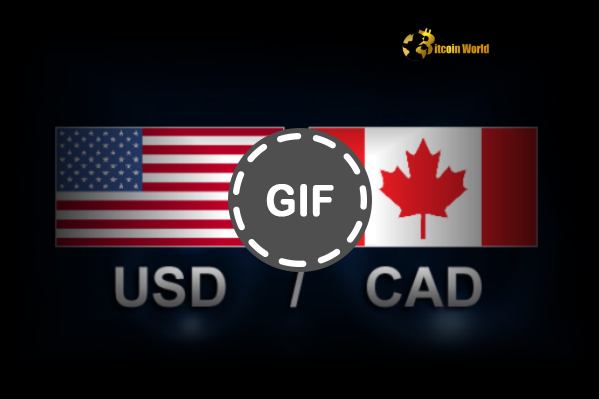BitcoinWorld

USD/CAD: BofA’s Stark Forecast – Why the Loonie Faces Headwinds Below 1.30
While the cryptocurrency market often captures headlines with its volatility and innovation, savvy traders know that understanding broader macroeconomic trends is crucial. Currency fluctuations, particularly involving major pairs like USD/CAD, can signal shifts in global economic sentiment that eventually ripple through various asset classes, including digital currencies. Recently, a notable BofA forecast has emerged regarding this key pair, suggesting a cautious outlook for the Canadian Dollar. Let’s delve into what Bank of America’s strategists are saying and what it implies for the Forex market.
Decoding the USD/CAD Pair: A Quick Look
The USD/CAD currency pair represents the exchange rate between the United States Dollar (USD) and the Canadian Dollar (CAD). It indicates how many Canadian Dollars are needed to purchase one US Dollar. As one of the most actively traded pairs, it is significantly influenced by factors affecting both economies, including:
- Monetary Policy: Decisions by the US Federal Reserve and the Bank of Canada (BoC) on interest rates and quantitative easing.
- Commodity Prices: Canada is a major exporter of commodities, especially oil. Changes in oil prices often impact the value of the Loonie.
- Economic Data: Employment reports, inflation figures, GDP growth, and trade balances in both countries.
- Geopolitical Events: Global risk sentiment can drive flows into or out of the respective currencies.
Why the Caution? Analyzing the Canadian Dollar‘s Outlook
Bank of America’s strategists, including تحلیل Du, have expressed caution regarding the potential for significant upside in the Canadian Dollar against the US Dollar. Their core view is articulated clearly: “We do not see USD/CAD below 1.30.” This statement is significant because a move below 1.30 would indicate a strengthening CAD relative to the USD. By stating they don’t anticipate this, BofA is essentially forecasting a floor around the 1.30 level, implying that the path of least resistance for the pair might be sideways or even upwards (a weaker CAD).
This cautious stance on the Loonie likely stems from a combination of factors. While specific details from the BofA analysis were not fully provided in the initial snippet, typical reasons for such a view could include:
- Monetary Policy Divergence: Expectations that the Federal Reserve might maintain higher interest rates for longer compared to the Bank of Canada, making the USD more attractive to yield-seeking investors.
- Economic Growth Differentials: Concerns that the Canadian economy might face headwinds or grow at a slower pace than the US economy.
- Commodity Price Sensitivity: While oil prices have seen volatility, persistent concerns about global demand or supply dynamics could weigh on the commodity-linked Canadian Dollar.
- Market Positioning: Existing market sentiment or positioning might favor the USD, making a significant breakthrough below 1.30 challenging without a strong catalyst.
Navigating the Forex Market: Implications of the 1.30 Threshold
For participants in the Forex market, BofA’s view that USD/CAD will not sustainably trade below 1.30 provides a potential anchor point for strategies. The 1.30 level acts as a psychological and technical support area. If the market accepts this BofA forecast, it suggests that attempts to push the pair lower might be met with buying interest around that level. This perspective has several implications:
For Traders Looking to Buy CAD:
Those betting on a stronger Canadian Dollar might need to reconsider their targets or look for strong catalysts that could challenge BofA’s view. The path below 1.30 is seen as blocked.
For Traders Looking to Buy USD:
Those betting on a stronger US Dollar (or weaker CAD) might see rallies towards 1.35 or higher as more probable than declines below 1.30, aligning with the cautious Loonie outlook.
For Risk Management:
Traders using 1.30 as a potential stop-loss or take-profit level should be aware of this prominent bank’s view. It could influence how the market reacts around that price point.
What Drives This Specific BofA Forecast?
While the snippet is brief, a major institution like Bank of America bases its forecasts on extensive research. Their view on USD/CAD likely incorporates analysis of:
- Detailed economic models for both the US and Canada.
- Projections for inflation and employment in both nations.
- Anticipated actions by the Federal Reserve and the Bank of Canada.
- Analysis of global demand and supply dynamics for key Canadian exports like oil.
- Assessment of investor sentiment and capital flows.
The specific mention of not seeing the pair below 1.30 suggests a strong conviction based on their internal models and expectations for these underlying drivers. It implies that, in their assessment, the factors supporting the US Dollar’s strength relative to the Canadian Dollar are expected to persist or outweigh factors that would strengthen the Loonie significantly.
Actionable Insights for Traders: Responding to the USD/CAD Forecast
Given this BofA forecast, how might a trader approach the Forex market, specifically the USD/CAD pair? Here are some considerations:
- Identify Key Levels: Recognize 1.30 as a significant potential support level according to BofA. Also, identify potential resistance levels above the current price.
- Watch Economic Data: Pay close attention to economic releases from both the US and Canada. Strong US data or weak Canadian data could reinforce BofA’s view, while the opposite could challenge it.
- Monitor Central Bank Commentary: Statements from the Fed and BoC officials regarding future monetary policy intentions are crucial. Any hawkish surprises from the BoC or dovish surprises from the Fed could shift the dynamics.
- Observe Oil Prices: Given the CAD’s link to commodities, significant moves in oil prices warrant attention. However, BofA’s view suggests that even favorable commodity prices might not be enough to push USD/CAD sustainably below 1.30 in their estimation.
- Consider Alternative Scenarios: While BofA has a clear view, the Forex market is unpredictable. Think about what kind of events (e.g., a major shift in global risk sentiment, unexpected policy moves) could cause USD/CAD to break below 1.30 despite this forecast.
- Manage Risk: Always use appropriate risk management techniques, such as setting stop-losses, regardless of expert forecasts. No forecast is guaranteed.
Potential Challenges to the BofA Forecast
While a major bank’s forecast carries weight, it’s important to remember that markets are dynamic. What could potentially challenge BofA’s view that USD/CAD stays above 1.30?
- A faster pace of interest rate cuts by the Federal Reserve than currently anticipated.
- Unexpected strength in the Canadian economy, leading the Bank of Canada to become more hawkish.
- A significant and sustained rally in commodity prices, particularly oil.
- A broad weakening of the US Dollar due to global factors or a shift in risk appetite favoring non-USD assets.
- Geopolitical developments that disproportionately benefit the Canadian Dollar.
These factors represent potential catalysts that traders should monitor as they evaluate the validity and potential duration of BofA’s cautious outlook on the Loonie.
Conclusion: What Does This Mean for the Forex Market?
Bank of America’s clear stance that they do not foresee USD/CAD trading below 1.30 underscores a prevailing caution regarding the near-term upside potential of the Canadian Dollar against the US Dollar. This BofA forecast suggests that the 1.30 level could act as a significant floor, influencing trading strategies and risk assessments in the Forex market. While forecasts are not guarantees, the view from a major institution like BofA provides a key data point for traders and investors navigating the complexities of currency movements. Understanding the underlying reasons behind this outlook – likely related to monetary policy expectations, economic fundamentals, and commodity price sensitivity – is essential for anyone trading or investing in this pair. As always, market participants should combine expert analysis with their own research and risk management practices.
To learn more about the latest Forex market trends, explore our article on key developments shaping Currency trading liquidity.
This post USD/CAD: BofA’s Stark Forecast – Why the Loonie Faces Headwinds Below 1.30 first appeared on BitcoinWorld and is written by Editorial Team





